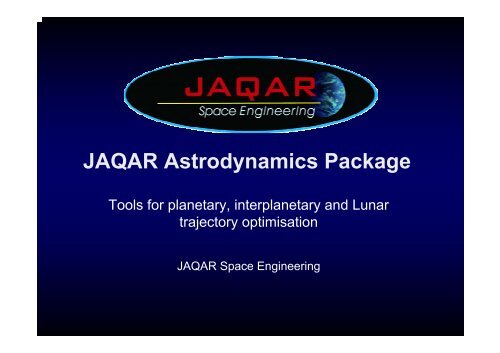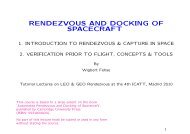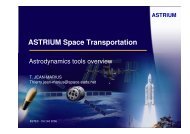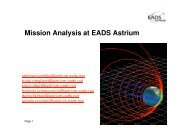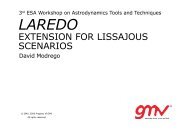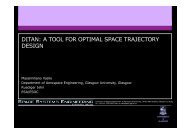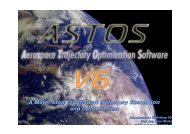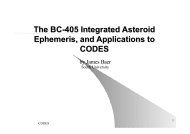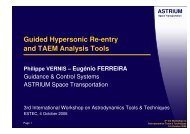JAQAR Astrodynamics Package - ESA
JAQAR Astrodynamics Package - ESA
JAQAR Astrodynamics Package - ESA
Create successful ePaper yourself
Turn your PDF publications into a flip-book with our unique Google optimized e-Paper software.
<strong>JAQAR</strong> <strong>Astrodynamics</strong> <strong>Package</strong>Tools for planetary, interplanetary and Lunartrajectory optimisation<strong>JAQAR</strong> Space Engineering
DefinitionThe <strong>JAQAR</strong> <strong>Astrodynamics</strong> <strong>Package</strong> is a set of tools, designed to:– Enable users to quickly and easily optimise trajectories• Preliminary assessment of both ascent and descent trajectoriesfrom and to a generic planet• Planetary transfers (one orbit to another)• Interplanetary transfers (one planet to another)• Lunar transfers (from Earth to the Moon and back)– Facilitate user in designing complex trajectories– Trade different orbit transfers in short time– Visualise results immediately– Export data to other tools (Excel/STK/etc.)
Features• Dedicated tools for dedicatedorbits• Easy to use graphicaluser interface• Use of both globaland local optimisers• Launcher performanceevaluation and databases• All tools run on PC usingWindows operating system• Free demos on theinternet
Software overview<strong>JAQAR</strong> <strong>Astrodynamics</strong> consists of 6 packages:• Swing-by Calculator (SBC)• Lunar Transfer Orbit Calculator (LTOC)• Orbit Transfer Optimiser (OTO)• Orbit Parameters Calculator (OPC)• STK Ephemeris Generator (STKephem)• Descent & Ascent Trajectory Optimiser (DATO) New
DATODescent & Ascent Trajectory OptimiserMr. Davide Starnone<strong>JAQAR</strong> Space Engineering, Italy, davidestarnone@inwind.itMr. Robin Biesbroek<strong>JAQAR</strong> Space Engineering, The Netherlands, robin@jaqar.com
DATO Capability• Preliminary assessment of both ascent and descenttrajectories from and to a generic planet, offering theopportunity to optimise the vehicle configuration andperformance, and to test some mission critical aspects.• Relevant results on the trajectory to put a wanted payloadin orbit or to land on a planet with the wanted MECO (MainEngine Cut-Off) velocity, can be generated, analysed andgraphically visualised.
DATO Software Structure(1/2)DATO is principally built on a structure of the following 5 Units:1. Main: to generate and manage the User interface;2. Thread: DE optimisation loops;3. DE Interface: Fitness function and some procedures to formulate thePhysics of the problem;4. RKN Propagation: numerical integration to propagate the trajectory;5. Derivative: Equations of Motion and evaluation of the principal flightparameters.Several additional secondary Units are used to support the primary unitsand to implement procedures, such as trajectory plots, data visualisation,genetic algorithms evaluation (crossover, mutation, selection).
DATO Software Structure(2/2)Through the GUI interface, the user can define the type of problem,ascent or descent. The User Interface is composed of four sections.
DATO Optimisation MethodGenetic Algorithm - Try to mimic a simple picture of natural selection inorder to find a good algorithm.Differential Evolution is a fast and reasonably robust stochastic paralleldirect search evolution strategy optimisation method.The crucial idea behind DE is ascheme for generating trialparameter vectors.Basically, DE adds the weighteddifference between 2 populationvectors to a third vector.This way no separate probabilitydistribution has to be used whichmakes the scheme completelyself-organizing.
DATO Problem ModellingAscent Trajectory (1/4)Basic Assumptions1. Rigid body;2. Two-dimensional motion.MotionThe motion is considered lying in theXLYL plane and the position of thevehicle is characterised by (R, !).The vehicle’s rotation is representedby "="(t).
DATO Problem ModellingAscent Trajectory (2/4)Trajectory Phase SubdivisionFirst Stage:Upper-Stages:1. Vertical ascent;2. Linear pitch law;3. Constant pitch law;4. Gravity turn.5. Gravity turn or Optimised pitch law.
DATO Problem ModellingAscent Trajectory (3/4)Optimised Flight ParametersDATO is able to optimise both space vehicle design and its trajectory.For Vehicle Design: (each stage)• Thrust over Weight ratio at ignition• Initial propellant massGLOW(Gross Lift-Off Weight)
DATO Problem ModellingAscent Trajectory (4/4)Optimised Flight ParametersFor Trajectory Design:1. Lift-off sequence2. Gravity turn orOptimised pitch control lawMaximising the DE Fitnessascent functionThat includes payload massand Glow ratio, wanted altitudeand wanted velocity on theorbit as well as constraints onmaximum heat flux andejection of the fairing• In case selected by the user, best functioning of the upper stage isobtained via optimisation of Coast-arc duration.
DATO Problem ModellingDescent Trajectory (1/3)Basic Assumptions1. Rigid body;2. Two-dimensional motion.MotionThe motion is considered lying in theXLYL plane and the position of thevehicle is characterised by sphericalcoordinates (R, !), with !=90 [deg].The vehicle’s rotation is representedby the pitch angle "="(t).
DATO Problem ModellingDescent Trajectory (2/3)Trajectory Phase SubdivisionFlight phase 1 – Descent Orbit Insertion (DOI): Impulsive manoeuvrefrom parking orbit (circular, elliptic or hyperbolic) to a lower altitude(optimised);Flight phase 2, 3, 4 – Powered Descent Initiation (PDI): divided into threeoperational phases (Braking, Approach, and Landing). During thethree powered descent phases, the vehicle’s mass decreases itsvalue during the motion, because of the consumption of thepropellant and for the eventual ejection of stages.
DATO Problem ModellingDescent Trajectory (3/3)Optimised Flight Parameters• Depending from the user selection, altitude or velocity to reach at theend of each phase is considered to optimise the duration of the descenttrajectory.• True anomaly at start of PDI phase is the initial condition to optimise theinitiation of the powered descent.• Initial angle of attack and its rate of variation are instead optimalparameters for the control law, guiding the vehicle to land.• An optimal descent trajectory is achieved, minimising the DE Fitnessdescent function, which principally acts on the difference between theflight and the maximum MECO velocity.
R # x $ y02 2DATO Problem ModellingEquations of Motiond Rdt , -&V'R& ' (V)( #!!) ( * + )%(, R )-& FX'L2V( )d & R ' 1 & V '! (m( t))dt(V) # ( ) $, ! - R V V FLocal ,* !.R -( )Local YL(, m( t))-LocalIntegration viaRunge-Kutta methodAscent Initial ConditionInitialR # R%$ hLaunchPadInitial! !LaunchPadVVInitialRInitial!## 0# R .+% %Descent Initial Condition2 2R0# x $ yy!0# arctg( ) xV # * V . sin $ V . cos/ ! ! 0/ ycosxsin 0R0 y 0 x 0V! # * V . ! * V . !0 0 0
R # x $ y02 2DATO Test Cases• Two optimisation of trajectory (ascent and descent testcases) are presented.• Examples are given for a lift launch vehicle and Lunardescent vehicles.• The obtained results are compared to referenced data.
R # x $ y02 2DATO Test CasesAscent Trajectory – VEGA launcherDeliver a payload of 2250 [kg] at 400 [km] of altitude without coast-arcduring the upper stage burn.VEGA Flight DataDATO OptimisationTotal ascent time 690 [s] 698.9 [s]Gross lift off mass 138 [tonnes] 141 [tonnes]T/W ratioStage 1T/W ratioStage 2T/W ratioStage 3T/W ratioStage 42.2 2.13 2.92 1.90.082 0.080
R # x $ y02 2DATO Test CasesAscent Trajectory – VEGA launcherA l ti tu d e [k m ]45040035030025020015010050000.00 02.53 05.46 08.38 11.31 14.24Time [min:sec]
R # x $ y02 2DATO Test CasesDescent Trajectory – LES-3 vehicle• The spacecraft was designed to transport apayload to the Lunar Surface.• A Soyuz-ST launch, followed by a direct transfer tothe Moon and Lunar Orbit Insertion, leaves a massof 1800 [kg] in Low Lunar Orbit (LLO). This is thestarting mass for the DOI.• That mission has the aim to land with the LunarExploration Module on the Moon surface with amaximum allowed vertical velocity at MECO equal to2 [m/s]. Descent is assumed to take place startingout from a 100 [km] LLO.
R # x $ y02 2DATO Test CasesDescent Trajectory – LES-3 vehicleLES-3 DataDATOOptimisationTotal descenttime651 [s] 642 [s]Landing Mass 971 [kg] 947 [kg]Ground track 540 [km] 532 [km]
R # x $ y02 2DATO Conclusions (1/2)• Fundamental aspect:Opportunity to optimise, via differential evolution algorithms,the vehicle performance and to test some mission criticalaspects of both ascent and descent trajectories from and to ageneric planet.
R # x $ y02 2DATO Conclusions (2/2)DATO main features:1. Extremely flexibility;2. Fast capability of evaluation;3. User friendly Interface.Next upgrades:1. Extension of motion at three-dimensional trajectories;2. Implementation of issues such as wind, thrust misalignment,launcher deflection, etc., causing the real trajectory todeviate from the nominal one.
<strong>JAQAR</strong> and STK• <strong>JAQAR</strong> and engineers of the Satellite Tool Kit (STK) have workedtogether to establish an effective interface between STK and the<strong>JAQAR</strong> <strong>Astrodynamics</strong> <strong>Package</strong>.• As a result:– SBC and LTOC create complete STK scenarios with trajectory filesalready imported– SBC, OTO and LTOC create complete STK scenarios based onnumerical propagation using STK/Astrogator.• An extra package exists to convert user-defined trajectory files to STKformat (STKephem).
Conclusions• The <strong>JAQAR</strong> <strong>Astrodynamics</strong> <strong>Package</strong> is a Commercially Off-The-Shelfset of tools, applicable to a wide variety of orbit transfers– Easy to use– Fast results– Exportability• <strong>JAQAR</strong> <strong>Astrodynamics</strong> is available to customers at an affordable price.– Customers include <strong>ESA</strong>, NASA (Goddard), SSTL (UK), MDRobotics (Canada), Orbital Sciences (USA).• Student license available– Hundreds of students all over the world are using it.
Questions?For more information:• Contact <strong>JAQAR</strong> atinfo@jaqar.com• Or: visit the web-site and download our demos:www.jaqar.com


